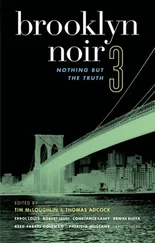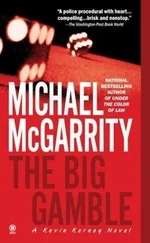Michael McGarrity - Nothing But Trouble
Здесь есть возможность читать онлайн «Michael McGarrity - Nothing But Trouble» весь текст электронной книги совершенно бесплатно (целиком полную версию без сокращений). В некоторых случаях можно слушать аудио, скачать через торрент в формате fb2 и присутствует краткое содержание. Жанр: Триллер, на английском языке. Описание произведения, (предисловие) а так же отзывы посетителей доступны на портале библиотеки ЛибКат.
- Название:Nothing But Trouble
- Автор:
- Жанр:
- Год:неизвестен
- ISBN:нет данных
- Рейтинг книги:4 / 5. Голосов: 1
-
Избранное:Добавить в избранное
- Отзывы:
-
Ваша оценка:
- 80
- 1
- 2
- 3
- 4
- 5
Nothing But Trouble: краткое содержание, описание и аннотация
Предлагаем к чтению аннотацию, описание, краткое содержание или предисловие (зависит от того, что написал сам автор книги «Nothing But Trouble»). Если вы не нашли необходимую информацию о книге — напишите в комментариях, мы постараемся отыскать её.
Nothing But Trouble — читать онлайн бесплатно полную книгу (весь текст) целиком
Ниже представлен текст книги, разбитый по страницам. Система сохранения места последней прочитанной страницы, позволяет с удобством читать онлайн бесплатно книгу «Nothing But Trouble», без необходимости каждый раз заново искать на чём Вы остановились. Поставьте закладку, и сможете в любой момент перейти на страницу, на которой закончили чтение.
Интервал:
Закладка:
Every year in September the city celebrated the Spanish reconquest of New Mexico with pageantry, religious services, music, dances, parties, and the public burning of Old Man Gloom. It was a time when a good number of the citizenry got drunk, started fistfights, brawled in bars, vandalized property, fought with spouses, drove under the influence, and occasionally shot or knifed each other. Additionally, the birthrate in the city always spiked nine months later.
Santa Fe’s finest hated fiestas so much that many officers counted their years to retirement by the number of remaining celebrations they would be forced to work before they turned in their pension papers.
The meeting, held in the council chambers at city hall, brought together supervisors and commanders of all local, county, and state law-enforcement agencies, plus fire department, EMT, county jail, and hospital ER personnel. Working through the full agenda took the whole morning. Decisions were made on the streets to be closed and manned by uniformed personnel, where first-aid stations would be set up, how many personnel would be assigned to saturation foot and roving traffic patrols, the number of plainclothes, undercover, and gang-unit teams that would operate during the long weekend, and where DWI checkpoints would be established.
After setting SWAT command-and-control protocols for crowd and riot control, the meeting moved on to a discussion of what bars, liquor establishments, and convenience stores would be targeted for alcohol sales to underage drinkers, and how transportation to the jail and hospital would be coordinated.
Kerney brought the meeting to a close with a word of thanks and the announcement that he would be on vacation during the fiesta, leaving Larry Otero, his second-in-command, in charge. Because his pending retirement was now common knowledge in all the cop shops, the news was greeted with a lot of grins, head shaking, and friendly catcalls.
When the last of the group dispersed, Kerney stopped by the mayor’s office and left word that he would stay on as chief until the new administration came into office. At the personnel office he picked up the application for pension forms that needed to be submitted at least sixty days in advance of his retirement.
Paperwork in hand, Kerney left the building. In six months he would become a civilian. For many cops retirement was a difficult milestone. But with Sara and Patrick in his life Kerney felt ready and eager for the future. He smiled at his good fortune as he walked to his unit.
In preparation for the tech scout Kerney read up on the history of the Bootheel, a part of New Mexico he’d never really explored. He also surfed the Internet for information and bought some maps of the area to study. In 1853, under the Gadsden Treaty, the United States bought from Mexico over twenty-nine-million acres along the border for a paltry ten million dollars. The land purchase stretched from the Rio Grande to the junction where the Colorado and Gila Rivers joined. The deal had been struck by the government on behalf of the railroad barons, who wanted a southern route to California. Thanks to political patronage a new international boundary was surveyed and the Bootheel was born.
Eventually, at the turn of the twentieth century, the railroad had been built not to California, but to the copper mines in Arizona. Just as eventually, some sixty years later, the tracks were abandoned and dismantled, thrusting the small towns that had grown up along the right of way into free-fall decay.
The night before the tech scout was to start, Kerney drove to Deming, a small city on Interstate 10 west of Las Cruces, and stayed in a motel. Although he wasn’t due to meet up with Johnny and the movie-people party until late in the afternoon, he’d come down early so he could poke around and take a quick tour on his own.
On a bright, cloudless Friday morning Kerney rolled into Hachita, one of the Bootheel villages devastated by the loss of commerce after the railroad had pulled out. An old locomotive water tank perched on tall steel pillars stood next to the raised rubble of the railbed, still visible under the weeds and shrubby bushes that had gained a strong foothold amid the rocks. Fronting the highway that passed by the settlement stood a low-slung white building that housed a cafe and store. Next to it was a garage that sold gas, and a boarded-up structure that, according to the sign above the door, had once been a food mart.
The cafe consisted of a half-dozen tables crammed into a narrow room. At one end a passageway led to the kitchen, and a small area directly behind the diner served as a grocery store of sorts, offering a few basics such as sugar, flour, bread, and canned goods, and a wider selection of snack foods and soft drinks. On the wall of the cafe were sport plaques and framed certificates that had been awarded to teenagers from the village who attended high school in Animas, some thirty miles distant.
At a window table in the empty cafe, Kerney ate breakfast. From the time it took to place his order and finish his meal, not one vehicle passed along the two-lane blacktop. The bill came to pocket change, and Kerney tripled the tip for the young woman who had served as both waitress and cook.
Back in his pickup truck he made a quick tour of Hachita, which sat almost squarely on the Continental Divide. In among the derelict buildings, broken-down trailers, and trashed-out, sandy lots filled with the skeletal remains of cars, trucks, and miscellaneous pieces of cannibalized heavy equipment were a few tidy, well-tended, occupied dwellings. Kerney figured no more than sixty people lived in the village proper.
Aside from the post office, a small, stuccoed structure with a pitched roof, the only other buildings of substance were an old brick schoolhouse now used as an occasional community center, and a Catholic church with a mortared stone vestibule and bell tower that soared above whitewashed adobe walls.
Beyond the village, at a distance much farther than the eye imagined, the raw and barren-looking Little Hatchet Mountains jutted up from the valley. The mining town of Playas, where the film company would be headquartered, sat due west on the slope of desert scrub hills, out of sight.
With hours to kill, Kerney turned south, away from Playas, and drove the state road that would take him to Antelope Wells, the most remote port of entry into Mexico along the entire international boundary. The chill of the early desert morning had long passed and the day was heating up. Kerney rolled down the windows to allow the sharp smell of dry air to wash over him, cruised down the empty highway at a leisurely pace, and let his gaze wander over the valley.
By western standards Kerney’s two sections of rangeland outside Santa Fe hardly qualified as a ranch. Although it contained some good pastureland and live water, a great deal of it consisted of rocky soil that had been overgrazed and invaded by pinon and juniper woodlands.
Kerney had little knowledge of modern land conservation practices, so to get up to speed he’d enrolled in a series of weekend workshops on restoring western rangeland. Using what he’d learned, he had begun to institute changes on his ranch. Last year he’d cut, lopped, and bulldozed over a hundred acres of woodland that had intruded into a pasture. He would burn the piles later in the fall and reseed the acreage the following spring with cool-season grasses. With that accomplished he planned to create some swales at the lower end of a pond where an arroyo was forming, so the water could spread out slowly and allow the marsh grass and cattails to stabilize the banks.
What Kerney had in mind to do was only a start. He had a great deal more to learn about good stewardship of his land. But he’d met a number of smart, well-informed people he could turn to for advice and information.
Читать дальшеИнтервал:
Закладка:
Похожие книги на «Nothing But Trouble»
Представляем Вашему вниманию похожие книги на «Nothing But Trouble» списком для выбора. Мы отобрали схожую по названию и смыслу литературу в надежде предоставить читателям больше вариантов отыскать новые, интересные, ещё непрочитанные произведения.
Обсуждение, отзывы о книге «Nothing But Trouble» и просто собственные мнения читателей. Оставьте ваши комментарии, напишите, что Вы думаете о произведении, его смысле или главных героях. Укажите что конкретно понравилось, а что нет, и почему Вы так считаете.












